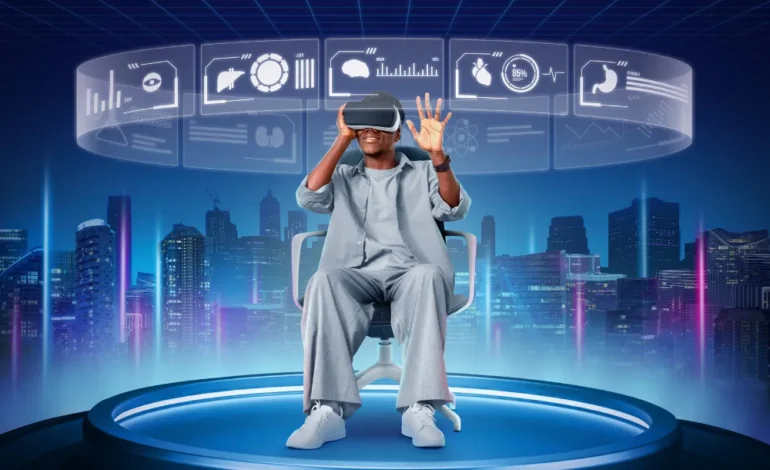
Tech Giants Envision Future Beyond Smartphones
Introduction
For more than a decade, smartphones have shaped our digital lives, defining how we communicate, navigate, shop, and work. But now, a growing consensus among the world’s leading technology innovators is challenging that status quo. Tech Giants Envision Future Beyond Smartphones, and their vision includes groundbreaking alternatives like AR glasses, brain-computer interfaces, and ambient computing environments. This article explores the technologies that might replace smartphones—and why this shift is already underway.
Why Are Smartphones Becoming Obsolete?
Despite their importance, smartphones are reaching their innovation ceiling. Foldable displays and high-refresh-rate screens offer incremental improvements, but the core interaction—touchscreen input—has remained largely unchanged for over a decade.
Tech leaders are asking an important question: Why be limited to a handheld screen when interaction can be more immersive, more intuitive, and even completely screenless?
Tech Giants Envision Future Beyond Smartphones. Issues like screen addiction, digital fatigue, and constant distraction have made users more conscious of the downsides of smartphone dependency. As a result, tech giants are accelerating research into devices that align better with human behavior and our natural senses—vision, hearing, and even thought. You can also check What does Durostech Tech Help for Every Tech Issue Anytime?
The Rise of AR Glasses: Your Next Daily Driver?
Among the most anticipated successors to the smartphone are AR (Augmented Reality) glasses. These lightweight, wearable devices overlay digital information onto the physical world in real time. Instead of looking down at a phone, users can see notifications, directions, or even full video calls directly in their field of vision.
Meta’s AR division, formerly known as Facebook Reality Labs, is investing billions into making AR glasses that blend seamlessly into everyday life. Google, too, is revisiting its early experiments with Google Glass with a more refined and privacy-conscious approach.
Tech Giants Envision Future Beyond Smartphones AR glasses promise to revolutionize industries—enhancing everything from virtual meetings and navigation to fitness and gaming—all while keeping your hands free.
Brain-Computer Interfaces: Control with a Thought
For some tech visionaries, even AR glasses aren’t futuristic enough. Brain-computer interfaces (BCIs) are emerging as the ultimate form of interaction, allowing users to control devices through neural signals alone.
Elon Musk’s Neuralink is perhaps the most talked-about project in this domain. The company is developing a BCI implant that allows users to move a cursor, type, or even control smart devices just by thinking. While early versions are being tested for medical purposes (e.g., restoring mobility in patients with paralysis), future consumer applications are already being envisioned.
Imagine composing a message or browsing the web without touching a device—just by thinking.
Wearable Tech: Smarter Than You Think
Wearable technology isn’t new—fitness trackers and smartwatches are already common—but next-generation wearables aim to replace the smartphone altogether. We’re not just talking about watches and earbuds anymore. New concepts include electronic tattoos and skin-mounted sensors that can measure health, transmit data, and connect to networks.
Tech Giants Envision Future Beyond Smartphones Microsoft, Samsung, and smaller startups are experimenting with flexible, low-power wearables that remain almost invisible while offering robust capabilities, from biometric monitoring to payment systems. These devices bring computing even closer to the human body.
As wearables evolve, their role will shift from accessories to primary interfaces with the digital world.
The Power of Ambient Computing
Ambient computing is one of the most transformative ideas in post-smartphone thinking. It refers to technology that exists all around us—connected, responsive, and intelligent—without requiring screens or even physical input devices.
AI-powered virtual assistants, embedded sensors, and interconnected devices could become so attuned to our needs that they anticipate them. Whether you’re cooking in the kitchen or walking through your smart home, systems powered by ambient computing would adapt to your environment and behavior, creating seamless interactions.
Tech Giants Envision Future Beyond Smartphones. This shift also relies on natural language processing, gesture recognition, and environmental context to function without screens, making smartphones feel clunky by comparison.
Virtual Reality Wearables: The Immersive Future
Alongside AR, virtual reality (VR) wearables offer immersive experiences that go far beyond what smartphones can deliver. While current VR headsets are often bulky, lighter versions are in development that will provide full access to entertainment, training, and communication in immersive 3D environments.
Companies like Apple (with its Vision Pro) and Meta (with Quest headsets) are exploring how VR can offer not just entertainment, but also practical tools for work and education. In such a world, a “smartphone” becomes a portal you wear, not carry.
Connectivity Infrastructure: 5G & 6G
All of this innovation hinges on connectivity. The arrival of 5G connectivity has enabled real-time data transfer at incredibly low latency. However, 6G vision is already in discussion, promising even faster speeds, more secure communications, and the capacity to handle the massive bandwidth demands of future devices like AR glasses and brain-connected wearables.
With such networks in place, data-hungry devices will function without delays, ensuring smooth user experiences across all connected platforms.
The Tactile Internet: Feel the Future
The Tactile Internet is another exciting innovation linked to the death of smartphones. It’s an internet where you can not only see and hear content but also feel it, thanks to haptic feedback systems.
These systems will allow users to experience texture, resistance, and even temperature through wearable tech or robotic interfaces. This has vast implications for industries like telemedicine, remote repair, gaming, and design.
Tech Giants Envision Future Beyond Smartphones, which are limited to visual and audio interactions, simply can’t compete with this multisensory leap forward.
The Privacy Puzzle in Wearable and Brain Tech
As wearables, AR glasses, and brain-computer interfaces become more integrated into our lives, new privacy concerns emerge. Devices that track brain signals, eye movement, and environmental data carry greater risks than conventional smartphones.
Protecting this data will be critical to public acceptance. Companies will need to design privacy-first architecture, ensure encryption, and maintain transparency about what’s collected and how it’s used. Without this, even the most advanced technologies may face resistance.
Apple’s Cautious Approach
While most companies are racing toward the post-smartphone future, Apple stands out for its caution. CEO Tim Cook has suggested that while he believes in the potential of wearables and AR, the smartphone isn’t going anywhere soon.
Instead of abandoning smartphones, Apple appears to be building an ecosystem around them, with wearables like the Apple Watch and Vision Pro supplementing, rather than replacing, the iPhone. This cautious, incremental approach may protect Apple’s existing market dominance, but could also leave it lagging in the next revolution. You can also check Apple iPhone 17 Pro Max: Full Specs, Features & Release Date
What Lies Ahead
The idea that Tech Giants Envision Future Beyond Smartphones is no longer speculative. It’s real, and it’s rapidly materializing. The shift is not about abandoning technology, but rather, integrating it more fluidly into our daily lives—making interactions less intrusive, more human, and often invisible.
We are moving toward a world where users won’t tap, swipe, or type—they’ll gesture, speak, and even think to interact with technology. The digital experience will be immersive, ambient, and deeply personalized.
FAQs
How will businesses adapt to a post-smartphone world?
Businesses will invest in wearable-compatible platforms, gesture-based interfaces, and voice-command tools. E-commerce, customer service, and workplace tech will evolve to support screenless and immersive experiences driven by AI and real-time data.
Are there health risks with always-on wearable technology?
Potential risks include prolonged exposure to sensors, electromagnetic fields, and privacy concerns. Long-term health data is still being studied, so regulation and consumer awareness will play a critical role in safe adoption.
What skills will future tech users need?
Users may need to become familiar with voice navigation, gesture controls, and data privacy settings. Basic knowledge of AI interactions and ethical tech use will also become increasingly important in daily life.
How will education change with post-smartphone technologies?
Education will shift toward immersive learning through AR/VR environments, AI tutors, and interactive simulations. This will make concepts easier to visualize, enhance accessibility, and offer personalized learning experiences beyond textbook limitations.
Conclusion
Tech Giants Envision Future Beyond Smartphones The smartphone won’t disappear overnight, but it will likely be remembered as the bridge between the desktop era and the era of ambient, wearable, and neural computing. Whether through AR glasses, virtual assistants, brain-computer interfaces, or haptic wearables, the next chapter in tech is already being written.
Tech Giants Envision Future Beyond Smartphones The companies leading this shift aren’t just inventing new devices—they’re redefining the very concept of connectivity, presence, and digital interaction. And soon, our fingers may no longer need to touch a screen at all.






